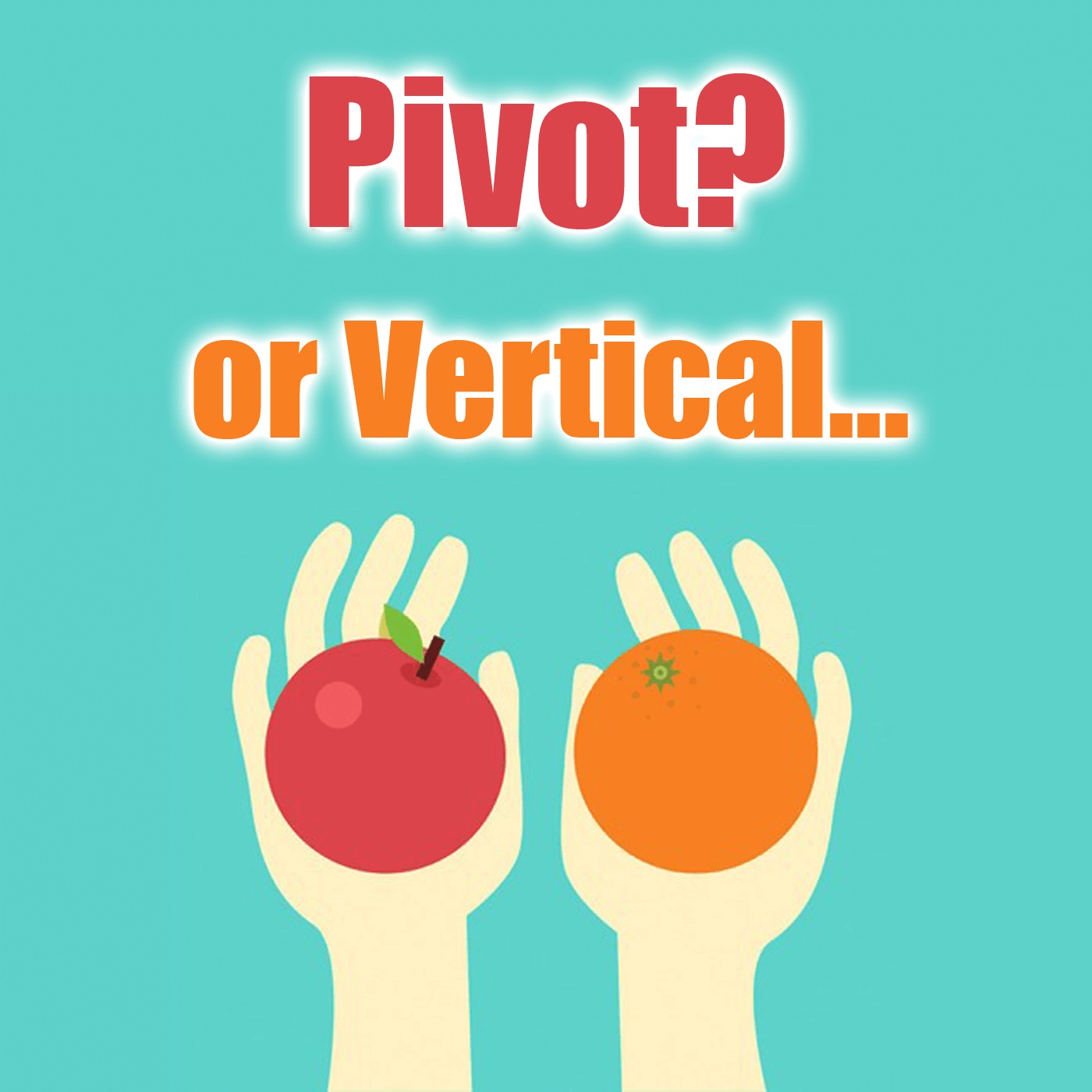When to pivot or add a vertical market to your business

Running your startup over the course of a couple of years with your team is a very challenging thing to do without funding. The few that have succeeded are the success stories that you hear every day. A lot of these large companies at one point did something different, but realized it wasn’t working out. So they switched their business model (pivoted) to something that worked and eventually that led to success.
Other companies find other areas in their industry called vertical markets and successfully launch other products that cater to those markets. The question is, how do you know when you should pivot your idea, or simply launch something in a vertical market? Well the answer has many variables. In this episode I explain both pivoting and vertical markets.
Here’s the transcript from this podcast episode, please excuse any typos!
In today’s episode we’re going to talk about the differences between a vertical and pivoting your startup or your business. The simple explanation is when you pivot your business, it means that you found a different business model, while you were building your company. And you changed it or you shifted, or you pivoted to that new business model, and not the original business model or idea, your concept might change as well, because you’re pivoting to a new concept. On the other hand, you may have found the vertical that you can tap into, which means your existing business stays the way it is, but you’re also able to tap into an additional business that’s related to your market in some way, or maybe not your market but your industry, where your idea just simply stays the same, and you’re applying it to another business model. Let’s say you own a restaurant and you serve mostly Italian food, but it seems as if most of your customers really only come in there for dessert for some reason.
Well, you may make a decision to change your format or your restaurant menu to only dessert. That would be a pivot. You would no longer be considered a food restaurant where you would sit down and eat dinner and instead you would be more of a dessert place or maybe even a bakery. And that might be a good business decision, if you’re finding out that you’re losing money on dinners, but you’re making a lot of money on desserts. Now on the other hand, your restaurant might be thriving on dinner and then one of your chefs comes to you with a dessert recipe coming down from his great grandmother, and he says hey I think I can make this dessert and start offering it to our customers. So you let your chef try it, and the dessert is a hit, everybody buys it after dinner and everybody loves the dessert, and that would be considered a vertical you’re adding something to your existing offerings you’re not changing your business you’re adding something to it. Now when it comes to a tech startup or a business, a pivot would be completely different. Let’s say you built a consumer app. It’s an app that helps you choose your outfit every morning.
So you take pictures of your clothing, and the next thing you know, in the morning, it gives you ideas of what you can wear so that you can save time. After running this tech startup for maybe six months you have enough data from your users to find out that the clothing suggestions isn’t really what they were using the app for it turns out all those pictures they were taking of their clothing and itemizing their clothing, it was mostly for inventory purposes so they knew what they had, or what they could donate or what they needed. So maybe then you pivot into an inventory clothing app, where it helps people purchase the items they’re missing or donate the items they don’t need anymore, all through the app where you could monetize the app. Every time somebody buys an item of clothing or donates one or needs one, you can earn a percentage of the profit from the sale.
So you started out with an inventory app that helps you give clothing suggestions in the morning to people and it turns out it’s more about finding the items they need or don’t want anymore, and you pivoted to that business model. On the other hand, let’s say your original idea of the clothing suggestion tool works and everybody loves that tool and they’re getting suggestions every morning for their clothing so you don’t have to pivot your business if it’s doing well. Now you know how I love data. And I love data driven decisions. So let’s say, 82% of your users through surveys that you send them say that they also want to include shoes and belts and ties into the app. But you were only going to be doing clothing that was your main business. Well, you can add a vertical, to the app, or you can even have a separate app just for ties, shoes, and other accessories, it’s the same industry but it’s a different business model, you’re no longer, helping them suggested, clothing, now it’s just accessories and shoes and things like that. So that’s one example of a pivot and a vertical. Here’s another one. Let’s say you are a really good dog groomer, and you want to start a dog grooming business, so you have say 50 dogs a month that you groom, and you’re doing really well, and people start asking you hey can you also groom. My llama or my horse or my cat or another animal that has a lot of hair, you think to yourself, you know if enough people are asking me about it. Why shouldn’t I do that? Well you would open a secondary location that would do those animals and that would be considered a vertical, you’re not pivoting your original business model, it’s still hair grooming it’s still Pet Grooming it’s still animal grooming. The difference being you’re spreading out to a different vertical to a different type of animal.
Now if you pivoted that business let’s say you also sell a lot of treats and dog accessories in your dog grooming business and it seems as if you’re not getting a lot of clientele to cut the hair. But boy, are you getting a lot of foot traffic to buy those accessories, and those treats. Well, that might tell you to pivot your business from dog grooming to dog treats and accessories, and that’s what your store should be, because that’s how you’re going to make the most profit. And that’s how you would figure out the pivoting based on what your business model is bringing you the most revenue. So now that you know the difference between pivoting and just opening a vertical market. How do you know when to do either one of those? That’s one of the main questions people ask me,
but when it comes to pivoting, you’ll know when it’s time to pivot because it’s just not working, your ad, people aren’t using it for what it was intended to be used for for your product people aren’t buying enough of it that they’re buying something else, viewers, or the service you’re providing, you’re just not getting enough customers but you see that you’re getting more customers for a different service you provide. Either way, when you find a business model or product or service that you are offering that is doing better than your original concept or your original service, that’s when you know you should pivot, or shift to that other business model because it’s more lucrative, you’re gonna make more money from it. And you’re going to spend less time being frustrated that you don’t have enough customers, you don’t have enough users, or your service isn’t being used enough.
Think of it like this. What if a community swimming pool, just didn’t get any people using it every summer, and they were spending all this money on chlorine and lifeguards and cleaning the pool but, like, one person would go there every day. But then the swimming pool owner would see, wait a minute, why there are like 50 skateboarders, not too far away on these broken ramps and using rails and whatever they’re using as it’s not good enough. Well maybe the swimming pool owner can put two and two together, and empty out the pool, add some cool added features and open up a skate park and a skate ramp and all these things and the kids can start coming there, maybe you can charge for food, concessions, and they’ll start buying food and drinks, he starts making a profit from it attracting kids to this awesome skate park. A more simplistic vertical could be something simple as a musician, maybe a musician is really good at playing the guitar and this person realizes that it gets hard is getting a lot of gigs, but he or she notices there are singers that are in need, and he or she can make more money by also singing as well, so they teach themselves how to sing or they already know how to sing so they open up that vertical to people and say hey look, I’m a guitarist for hire, but I can also sing, and now that person may make double the money than they normally would have by only having one business. This is a vertical still music, still offering a service in music, so now they’re doubling their income, playing the guitar and singing, maybe at the same time maybe different locations different gigs, one gig or singing one gig or playing guitar maybe you’re doing both at a gig. Either way, you’re doubling your chances of getting jobs. So that’s really what a vertical is when you open your market.
More people ask me if I’ve ever pivoted, or if I had a vertical and of course I have. So this one time in roughly 2010, I had a startup called Pickler phi. It was an eBay meets Craigslist meets Facebook, it was a very social way to sell your items and to allow people to buy them from you, very easily without any fraud. We noticed a lot of people were listing things for sale but people weren’t buying them and when we reached out to our users to find out why they said the prices weren’t that great. So we asked them what prices would you like, and they started you knowingly mentioning the prices they wanted and we would contact the sellers to let them know. So we realized hey, maybe we should pivot into a reverse auction site which we did, we ended up pivoting so then people that wanted to buy items would list an item they wanted to buy or a certain price. And then if a seller, anybody had this item in their garage or their basement of their house and they were willing to sell it for that price, it would be matched, then they could immediately start to communicate through the website and then you know to purchase items from each other. So it was kind of like a reverse auction and it was a pivot, we completely changed our business model.
Another example, recently from Instamour video dating I went into more video discovery so now instead of it being a dating app now it is a discovery app so you don’t just meet people for dates you meet them for activities, I pivoted from dating to activities and interests. It’s more like let’s go hiking and get coffee and walk our dogs and go see a movie activity based and they can be friends and roommates or business partners or dating if you wish. And here’s an example of the same company customer where I did a vertical. And this is because of investors so this is a really good lesson to learn. When you pitch your startup to investors, they tell you that they only invest in certain markets, industries or concepts. You hear it over and over and over again, you might consider building the same platform as a vertical for their market, which is what we did with instamorph so we built See2B, you can see to the business, meaning we use video to allow people to go to a business website and instantly video chat with customer service, or the owner of the company to get a more real time view of the business as well as showcasing the factory floor or the actual storefront business so they can see the business that’s what that’s why we called it See2B. And that was vertical, because we still had instamorph running as a dating app, but we were pitching the business side of the business See2Bto investors. And we actually want to contest through Comcast where you pitch your business, we actually want a cash prize to build out our product and we built it out, and we did pretty well with it until we couldn’t get funding for it, of course, as usual, that’s just the way the world works and you’ll learn as you run a business that funding is very hard to get. Which is why you have to be cognizant of pivoting and verticals, because the reason you’re doing those two, whether it’s a pivot or vertical. It’s literally for one reason, because it’s the smart move to get investors. If your business is running really well, and you’re making tons of money and you don’t need investors, then you don’t need to pivot or vertical. I mean you could do them.
If you want to maybe add more money to the business, you can do a vertical if you want to add to it but why pivot, if you’re doing well. So realistically you’re only going to pivot, if your business model is not working, you’re losing money you’re not getting investors and you see a better idea in your technology that you can leverage and with the vertical The only reason you do that is if your business is thriving, but you see another avenue of monetization that you can add and just add it on what I’ve always found fascinating is these super large companies that you probably didn’t even know pivoted, I can name some of them, Twitter, PayPal Groupon Starbucks Nokia flicker HP Nintendo, Instagram, I can go on and on these companies actually started out with a different business model and found that they had to pivot, they had to change. Ironically enough Twitter started out as a podcast platform, it let you find and subscribe to podcasts, but when they found iTunes taking over the podcast arena. They pivot into microblogging. And that’s when Twitter was born. Interestingly enough, Starbucks started out selling espresso makers and coffee beans, but when he realized that he could actually sell the coffee itself. All the rest is history. One of my favorites is flicker because it actually started out as an online role playing game or an RPG called the game never ending and users would travel around a digital map they would interact with each other and buy and sell and build items kind of like Minecraft a little bit, I guess, but the game also included a photo sharing tool, and that ended up being the most popular part of the game. So because it was so popular they decided let’s just forget the game and let’s pivot to flicker, a photo sharing app.
![]()






